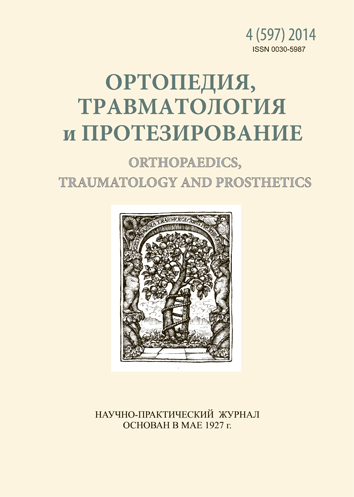Diagnostics of rotational displacements in the shin fractures and a comparative assessment of the possibilities of three circular devices for external fixation for elimination of them
DOI:
https://doi.org/10.15674/0030-59872014485-92Keywords:
bone, external fixation, tibia, fracture, displacement, rotation, apparatus for external fixation, footingAbstract
Objective: To develop a method of diagnostics of direction and magnitude of rotational displacement under conditions of shin bone fractures and to compare opportunities of the apparatus of Ilizarov, Taylor and Matsukidis-Shevtsov to eliminate them. Methods: CT scanning of shins in 25 healthy individuals (11 women, 14 men) aged from 18 to 65 years. There was made a graphic analysis of transverse sections of the tibia reproducing every 5 mm from the knee to the ankle joint. For comparative analysis of capabilities of external fixation devices we selected three representative group of 49 patients whom osteosynthesis of shin fractures type A1 with Ilizarov apparatus (21 people), Taylor (7) and Matsukidisa-Shevtsova (21) performed in. The direction and magnitude of the rotational displacement we determined according to the developed method and performed their correction after that. We compared duration of manipulation carried out and accuracy of elimination of rotational displacement. Results: There were revealed consistent patterns of change in the width of the X-ray shadow of the distal tibia fragments depending on the direction of its rotation turnround. There was developed a method for diagnostics of orientation of rotational displacements and derived mathematical formula for calculating of their value. For ease of use the author’s method of assessment of rotational displacements in the clinical setting there was proposed a template method for estimation of its parameters. There was not found significant differences in the length and precision of manipulations for elimination of rotational displacements between the Ilizarov and Taylor apparatus, and duration of similar action with Matsukidis-Shevtsov apparatus was almost in ten times less with much more accurate correction terms. Conclusion: The proposed method makes it possible to accurately determine the magnitude and direction of the rotational displacement of the tibia fracture and the Matsukidis-Shevtsov apparatus has the best opportunities to eliminate them.
References
- Барабаш А. П. Атлас идеального остеосинтеза диафизарных переломов костей голени / А. П. Барабаш, И. А. Норкин, Ю. А. Барабаш. — Саратов: Оформитель, 2009. — 64 с.
- Беляков А. А. Отдаленные исходы лечения больных с переломами диафиза костей голени / А. А. Беляков // Ортопедия, травматология и протезирование. — 1980. — № 10. — С. 38–41.
- Волков М. В. Ошибки и осложнения при лечении переломов костей / М. В. Волков, О. Н. Гудушаури, О. А. Ушакова. — М.: Медицина, 1970. — 182 с.
- Гафаров Х. З. Лечение деформаций стоп у детей / Х. З. Гафаров. — Казань: Татарское кн. изд-во, 1990. — 176 с.
- Девятов А. А. Чрескостный остеосинтез / А. А. Девятов. — Кишинев: Штиинца, 1990. — 316 с.
- Классика и новации чрескостного остеосинтеза в ортопедии / [А. Г. Каплунов, А. П. Барабаш, И. А. Норкин и др.]. — Саратов: Новый ветер, 2007. — 312 с.
- Корж Н. А. Наш опыт лечения длинных костей / Н. А. Корж, А. К. Попсуйшапка, Л. Д. Горидова // Ортопедия, травматология и протезирование. — 1996. — № 3. — С. 35–38.
- Морозов В. П. Применение компрессионно-дистракционных аппаратов при закрытых переломах голени / В. П. Морозов, А. В. Кузнецов: материалы Всерос. конф., посвящ. 5-летию Гос. науч.-клинич. центра охраны здоровья шахтеров [«Актуальные проблемы здравоохранения Сибири»]. — Ленинск-Кузнецкий, 1998. — С. 107–108.
- Оганесян О. В. Основы наружной чрескостной фиксации / О. В. Оганесян. — М.: Медицина, 2004. — 432 с.
Downloads
How to Cite
Issue
Section
License
Copyright (c) 2014 Ivan Martel, Sergey Shved, Feder Matsukatov

This work is licensed under a Creative Commons Attribution 4.0 International License.
The authors retain the right of authorship of their manuscript and pass the journal the right of the first publication of this article, which automatically become available from the date of publication under the terms of Creative Commons Attribution License, which allows others to freely distribute the published manuscript with mandatory linking to authors of the original research and the first publication of this one in this journal.
Authors have the right to enter into a separate supplemental agreement on the additional non-exclusive distribution of manuscript in the form in which it was published by the journal (i.e. to put work in electronic storage of an institution or publish as a part of the book) while maintaining the reference to the first publication of the manuscript in this journal.
The editorial policy of the journal allows authors and encourages manuscript accommodation online (i.e. in storage of an institution or on the personal websites) as before submission of the manuscript to the editorial office, and during its editorial processing because it contributes to productive scientific discussion and positively affects the efficiency and dynamics of the published manuscript citation (see The Effect of Open Access).














